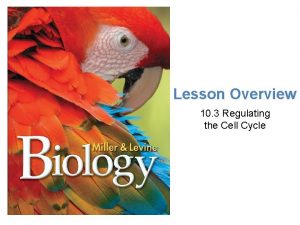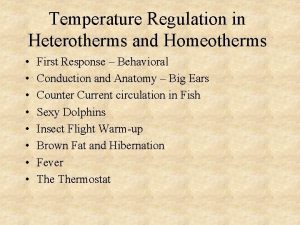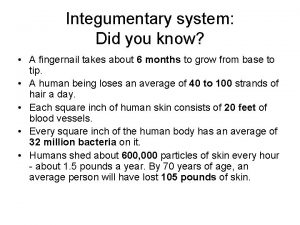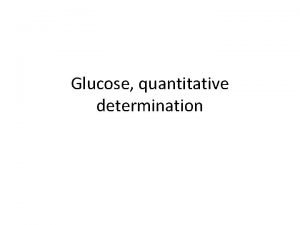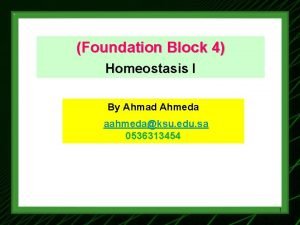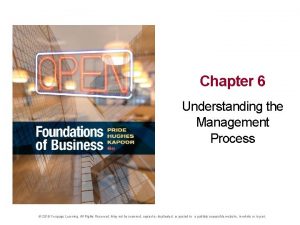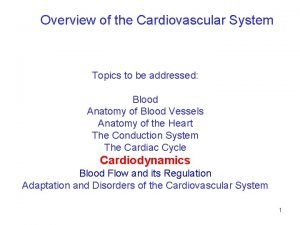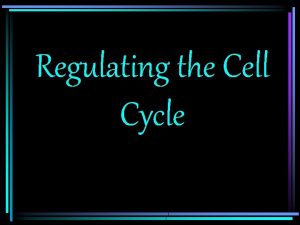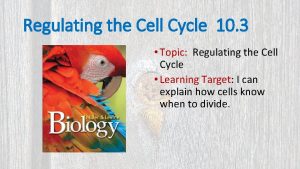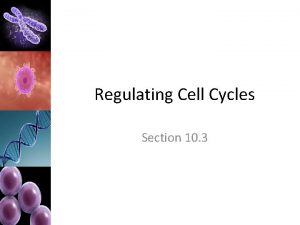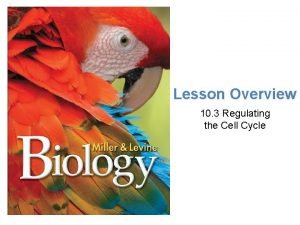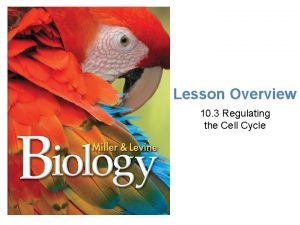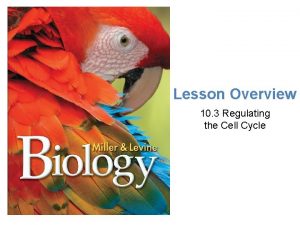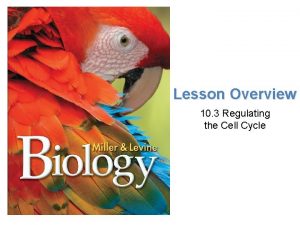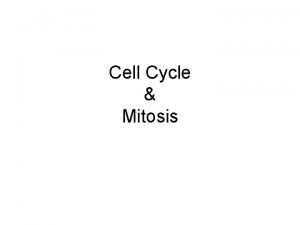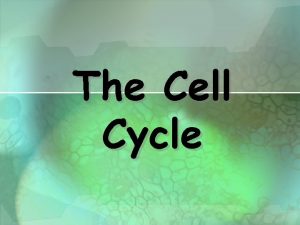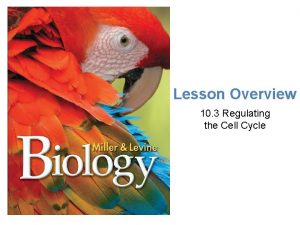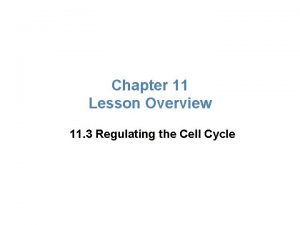Lesson Overview Regulating the Cell Cycle Lesson Overview



















- Slides: 19

Lesson Overview Regulating the Cell Cycle Lesson Overview 10. 3 Regulating the Cell Cycle

Lesson Overview Regulating the Cell Cycle The controls on cell growth and division can be turned on and off. For example, when an injury such as a broken bone occurs, cells are stimulated to divide rapidly and start the healing process. The rate of cell division slows when the healing process nears completion.

Lesson Overview Regulating the Cell Cycle The Discovery of Cyclins are a family of proteins that regulate the timing of the cell cycle in eukaryotic cells. This graph shows how cyclin levels change throughout the cell cycle in fertilized clam eggs.

Lesson Overview Regulating the Cell Cycle Regulatory Proteins Internal regulators are proteins that respond to events inside a cell. They allow the cell cycle to proceed only once certain processes have happened inside the cell. External regulators are proteins that respond to events outside the cell. They direct cells to speed up or slow down the cell cycle. Growth factors are external regulators that stimulate the growth and division of cells. They are important during embryonic development and wound healing.

Lesson Overview Regulating the Cell Cycle

Lesson Overview Regulating the Cell Cycle He. La Cells The Story of Henrietta Lacks http: //www. youtube. com/watch? v=0 g. F 8 b. CE 4 wq. A&feature=related

Lesson Overview Regulating the Cell Cycle Apoptosis is a process of programmed cell death. Apoptosis plays a role in development by shaping the structure of tissues and organs in plants and animals. For example, the foot of a mouse is shaped the way it is partly because the toes undergo apoptosis during tissue development.

Lesson Overview Regulating the Cell Cycle Cancer and the Cell Cycle Cancer is a disorder in which body cells lose the ability to control cell growth. Cancer cells divide uncontrollably to form a mass of cells called a tumor.

Lesson Overview Regulating the Cell Cycle Cancer and the Cell Cycle A benign tumor is noncancerous. It does not spread to surrounding healthy tissue. A malignant tumor is cancerous. It invades and destroys surrounding healthy tissue and can spread to other parts of the body. The spread of cancer cells is called metastasis. Cancer cells absorb nutrients needed by other cells, block nerve connections, and prevent organs from functioning.

Lesson Overview Regulating the Cell Cycle What Causes Cancer? Cancers are caused by defects in genes that regulate cell growth and division. Some sources of gene defects are smoking tobacco, radiation exposure, defective genes, and viral infection. A damaged or defective p 53 gene is common in cancer cells. It causes cells to lose the information needed to respond to growth signals.

Lesson Overview Regulating the Cell Cycle Treatments for Cancer Some localized tumors can be removed by surgery. Many tumors can be treated with targeted radiation. Chemotherapy is the use of compounds that kill or slow the growth of cancer cells. Cancer Warrior PBS

Lesson Overview Regulating the Cell Cycle From One Cell to Many All organisms start life as just one cell. Most multicellular organisms pass through an early stage of development called an embryo, which gradually develops into an adult organism. During development, an organism’s cells become more differentiated and specialized for particular functions.

Lesson Overview Regulating the Cell Cycle Defining Differentiation The process by which cells become specialized is known as differentiation. During development, cells differentiate into many different types and become specialized to perform certain tasks.

Lesson Overview Regulating the Cell Cycle Human Development Biologists say that such a cell is totipotent, literally able to do everything, to form all the tissues of the body. (a fertilized egg) After about four days of development, a human embryo forms into a blastocyst, a hollow ball of cells with a cluster of cells inside known as the inner cell mass. The cells of the inner cell mass are said to be pluripotent, which means that they are capable of developing into many, but not all, of the body's cell types.

Lesson Overview Regulating the Cell Cycle Stem Cells Stem cells are unspecialized cells from which differentiated cells develop.

Lesson Overview Regulating the Cell Cycle Embryonic Stem Cells Embryonic stem cells are found in the inner cells mass of the early embryo. Embryonic stem cells are pluripotent. Researchers have grown stem cells isolated from human embryos in culture. Their experiments confirmed that embryonic stem cells have the capacity to produce most cell types in the human body.

Lesson Overview Regulating the Cell Cycle Adult Stem Cells Adult organisms contain some types of stem cells. Adult stem cells are multipotent. They can produce many types of differentiated cells. Adult stem cells of a given organ or tissue typically produce only the types of cells that are unique to that tissue.

Lesson Overview Regulating the Cell Cycle Potential Benefits Stem cell research may lead to new ways to repair the cellular damage that results from heart attack, stroke, and spinal cord injuries.

Lesson Overview Regulating the Cell Cycle Ethical Issues Most techniques for harvesting, or gathering, embryonic stem cells cause destruction of the embryo. Government funding of embryonic stem cell research is an important political issue. Groups seeking to protect embryos oppose such research as unethical. Other groups support this research as essential to saving human lives and so view it as unethical to restrict the research. BBC Documentary
 Section 10-3 regulating the cell cycle
Section 10-3 regulating the cell cycle Cell cycle
Cell cycle Piloerection
Piloerection Regulating body temperature
Regulating body temperature Ogtt curve
Ogtt curve Regulating body temperature
Regulating body temperature Chapter 6 understanding the management process
Chapter 6 understanding the management process Igoole
Igoole Factors regulating cardiac output
Factors regulating cardiac output Events of the cell cycle
Events of the cell cycle Cell cycle and cell division
Cell cycle and cell division Biology.arizona.edu/cell bio/activities/cell cycle/01.html
Biology.arizona.edu/cell bio/activities/cell cycle/01.html Phases of cell cycle
Phases of cell cycle Cell signaling overview
Cell signaling overview Hát kết hợp bộ gõ cơ thể
Hát kết hợp bộ gõ cơ thể Bổ thể
Bổ thể Tỉ lệ cơ thể trẻ em
Tỉ lệ cơ thể trẻ em Voi kéo gỗ như thế nào
Voi kéo gỗ như thế nào Thang điểm glasgow
Thang điểm glasgow

